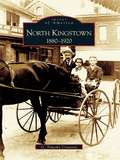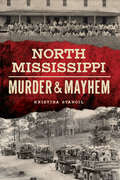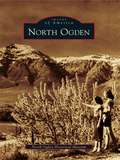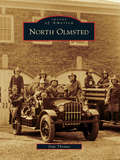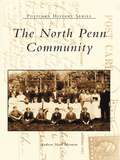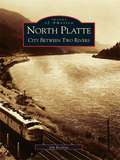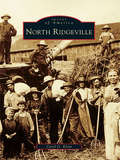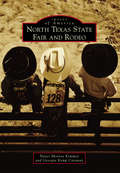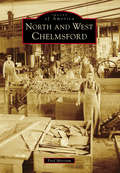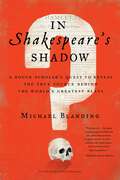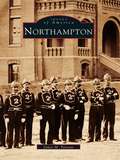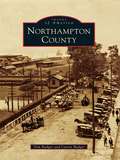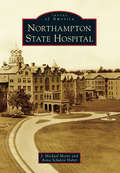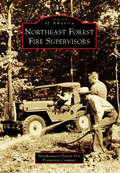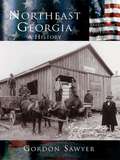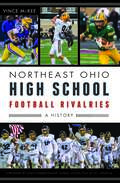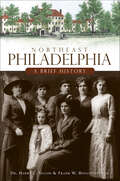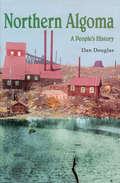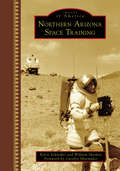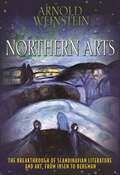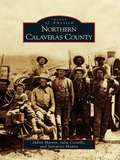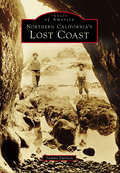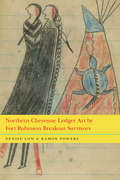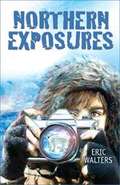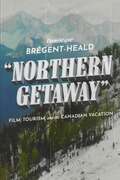- Table View
- List View
North Kingstown: 1880-1920
by G. Timothy CranstonIn the late 1880s, pharmacist Elwin "Doc" Young began to photograph the people, places, and events in his bustling crossroads community of North Kingstown. He turned the best of these images into postcards and sold them in hisapothecary shop. Today, readers can admire Young's impressive art in this volume, North Kingstown: 1880-1920. These pages highlight North Kingstown's golden era--a time when elite East Coast families on their way to Newportwould stop in quaint villages and mingle with the residents. These captivating images show the people, technology, and architecture of an important city at the beginning of the20th century.
North Mississippi Murder & Mayhem (Murder & Mayhem)
by Kristina StancilNorth Mississippi's idyllic rolling hills and deep forests hide a history steeped in blood. America's first serial killers, the Harpe brothers, brutally murdered as many as fifty people at the end of the 1700s before finally meeting their end on the Natchez Trace. During Reconstruction, politician William Clark Falkner, great-grandfather of the author William Faulkner, was shot in the streets of Ripley by a former business partner after being elected to the state legislature. In the 1960s, Samuel Bowers and the Mississippi Klan tried to start a national race war by orchestrating the Freedom Summer murders and the Ole Miss Riot. Kristina Stancil details the shadowy side of North Mississippi.
North Ogden
by North Ogden Historical MuseumNorth Ogden is a quiet community nestled in the foothills of the Wasatch Mountains. The majestic Ben Lomond Peak silently towers over the city to the north with Lewis Peak standing guard to the east. Beautiful panoramic scenery is enjoyed in all directions. During the early 19th century, the city and surrounding areas were inhabited by the Spanish and Native Americans and explored by trappers. North Ogden City was established in 1851, and the challenges facing the pioneer families were numerous. Settlers encountered hostile Native Americans, hungry wild animals, devastating grasshopper invasions, and extreme weather conditions, and the food supplies were often depleted. Regardless, the city's population thrived, and farms, orchards, and businesses prospered. The perseverance of those early settlers is linked to the rich heritage treasured by the citizens of today.
North Olmsted (Images of America)
by Dale ThomasNorth Olmsted's history began in 1815 with David Johnson Stearns of Vermont. Stearns was followed to the area by other pioneers from New England, and they established a settlement in the wilderness of southwestern Cuyahoga County. North Olmsted went from being an isolated farming community to a village in 1908 and then to a city in 1951. The stage was then set for it to rapidly grow into a thriving suburb in the last half of the 20th century. North Olmsted's rich heritage is illustrated in this book through historic photographs from the Olmsted Historical Society that highlight the city's residents, businesses, social centers, and schools.
North Penn Community, The (Postcard History)
by Andrew Mark HermanSparsely settled in the late 1600s, the area of Montgomery County known as the North Penn region began to be populated in the early 1700s by Welsh Baptists, Quakers, and German Mennonites. The North Penn Community not only highlights the region but also offers detailed accounts of the communities of Lansdale, North Wales, Hatfield, Colmar, Montgomeryville, West Point, and Kulpsville. Postcard images from 1905 through 1970 illustrate many historical sites such as farms, homes, hotels, stores, schools, churches, and other important parts of the community, chronicling the area from its original settlement of the 1700s to the bustling suburb of Philadelphia that it is today.
North Platte: City Between Two Rivers
by Jim BeckiusSituated at the junction of the North Platte and South Platte rivers, North Platte has a long history as an important stopping point in the westward migration of from the days of the California gold rush to the building of the transcontinental railroad and beyond. The Oregon Trail to the gold rush followed the South Platte River, and the Mormon Trail followed the North Platte River. In 1866 the building of the Union Pacific railroad stopped at North Platte for the winter. The railroad brought the town of North Platte to life. In 1869 the Union Pacific built a huge depot and hotel which stood until destroyed by fire in 1915. It entertained many famous visitors including William F. Cody, George Armstrong Custer, Bat Masterson, and Teddy Roosevelt. Since the 1920s North Platte has grown considerably, helped by the transcontinental Lincoln Highway which still runs through town. North Platte also had the first lighted runway in the United States, used for the air mail planes of the 1920s.
North Ridgeville (Images of America)
by Carol G. KlearNorth Ridgeville took root when 17 men, mostly members of the Beebe and Terrell families, left Waterbury, Connecticut, traveled west to Ohio, and established the first permanent settlement on May 10, 1810. Ridgeville Township was organized in 1813, centered at State Routes 20 and 83, and by the mid-1800s welcomed many people of German and English descent. In 1829, due to frequent mail mix-ups with Ridgeville, a town near Dayton, the postmaster general requested that the post office be named North Ridgeville. What was once a small farming community began to grow and prosper, and by 1958, North Ridgeville was incorporated as a village; two years later it became a city. Today the population nears 30,000, and North Ridgeville is flourishing, thanks to the hard work, determination, and pride of its forefathers.
North Texas State Fair and Rodeo (Images of America)
by Nanci Monroe Kimmey Georgia Kemp CarawayThe predecessor to the North Texas State Fair and Rodeo was reported in the October 15, 1885, Denton Doings as consisting of horse races sponsored by the Denton County Fair and Blooded Stock Association (DCFBSA). The next mention was 1890, when the association stockholders had the opportunity to purchase shares of the fairgrounds, thus ending the fair until five years later. The DCFBSA was reorganized in 1895 to host a fair and horse race near North Texas Normal College. The next race was held in 1896, and the association was incorporated. The fair has operated continuously since except for the years during World War II. These early events evolved into one of the largest fairs and rodeos in Texas, drawing more than 150,000 fairgoers annually.
North and West Chelmsford (Images of America)
by Fred MerriamThe Massachusetts town of Chelmsford, chartered in 1655, consisted of five villages. In the 1820s, industries related to the production of cast iron, textiles, and textile mill machinery made their first appearance in the North village along Stony Brook. Its social and economic life became aligned with the new industrial city of Lowell, and there had even been talk of secession from the Centre village in the mid-1800s. A golden age of industrial expansion and production occurred from 1875 to 1910. Industry in the West village consisted of blade and textile manufacturing in two locations, also tied to water power on Stony Brook, but this community was aligned socially and economically with nearby Nabnasset village in Westford. Discover the golden age of the North and West villages in photographs and learn about the people who made it happen.
North by Shakespeare: A Rogue Scholar's Quest for the Truth Behind the Bard's Work
by Michael BlandingThe true story of a self-taught Shakespeare sleuth&’s quest to prove his eye-opening theory about the source of the world&’s most famous plays, taking readers inside the vibrant era of Elizabethan England as well as the contemporary scene of Shakespeare scholars and obsessives.Acclaimed author of The Map Thief, Michael Blanding presents the twinning narratives of renegade scholar Dennis McCarthy, called &“the Steve Jobs of the Shakespeare community,&” and Sir Thomas North, an Elizabethan courtier whom McCarthy believes to be the undiscovered source for Shakespeare&’s plays. For the last fifteen years, McCarthy has obsessively pursued the true origins of Shakespeare&’s works. Using plagiarism software, he has found direct links between Hamlet, Macbeth, Romeo and Juliet, and other plays and North&’s published and unpublished writings—as well as Shakespearean plotlines seemingly lifted straight from North&’s colorful life.Unlike those who believe someone else secretly wrote Shakespeare, McCarthy&’s wholly original conclusion is this: Shakespeare wrote the plays, but he adapted them from source plays written by North decades before. Many of them, he believes, were penned on behalf of North&’s patron Robert Dudley, in his efforts to woo Queen Elizabeth. That bold theory addresses many lingering mysteries about the Bard with compelling new evidence, including a newly discovered journal of North&’s travels through France and Italy, filled with locations and details appearing in Shakespeare&’s plays.North by Shakespeare alternates between the enigmatic life of Thomas North, the intrigues of the Tudor court, the rivalries of English Renaissance theater, and academic outsider Dennis McCarthy&’s attempts to air his provocative ideas in the clubby world of Shakespearean scholarship. Through it all, Blanding employs his keen journalistic eye to craft a captivating drama, upending our understanding of the beloved playwright and his &“singular genius.&”
Northampton
by James M. ParsonsThe beauty of the Connecticut River Valley in Massachusetts has always left visitors groping for superlatives, and the town of Northampton--once dubbed "The Athens of the Connecticut Valley"--has lately experienced a renaissance. Interest in the city has only risen through the years, and an assessment of its prominence throughout history easily explains its consistent attraction. From its settling in 1654 to the present, Northampton has been a hotbed of activity, idealism, growth, and change. Walking the streets of Northampton at different times were revolutionaries like Daniel Shays, patriots like Joseph Hawley, religious visionaries like Jonathan Edwards, idealists like the members of the utopian community in Florence, and governors like Caleb Strong and future president Calvin Coolidge. Notables like Sojourner Truth, Alexander Graham Bell, and President Franklin Pierce came and left, but their influences have remained.
Northampton County (Images of America)
by Curtis Badger Tom BadgerShortly after European colonists landed at Jamestown in 1607, they established a settlement in Northampton County. Settlers caught fish and shellfish in the shallow bays and creeks along the seaside and bayside and distilled salt from seawater to help preserve this bounty through the winter. Since 1608, Northampton has provided food for Virginia and the world. Fishing, crabbing, and clam aquaculture today are still an important part of the economic backbone of Northampton, but Northampton has been best known in recent years for land-based food production. The sandy soils of Northampton have always been productive, but when the railroad was built in 1884, it gave growers a method of getting produce to markets in a timely manner. So Northampton's history and culture have centered around food--gathering it, producing it, and shipping it--and the photographs in Images of America: Northampton County document this legacy.
Northampton State Hospital
by J. Michael Moore Anna Schuleit HaberNorthampton State Hospital, established in 1856, was built with the optimistic spirit of humanitarian reform. For many years, it was run by Dr. Pliny Earle, a champion of treatment that combined individualized care with manual labor, religious worship, recreation, and amusement. This vision was overwhelmed as the hospital was called upon to care for ever-larger numbers of people with varying needs. By the mid-20th century, the hospital was an isolated small "city," with hundreds of employees caring for more than 2,000 patients in overcrowded and inadequate conditions. It became a nationally important center of political and legal struggle over the role of state hospitals in the care of the mentally ill. After being gradually phased out, the hospital was closed in 1993, and the buildings, though listed in the National Register of Historic Places, were demolished in 2006. This volume brings to life the 135-year story of Northampton State Hospital through beautiful and haunting photographs drawn from the collections of Historic Northampton, the city's local history museum.
Northeast Forest Fire Supervisors (Images of America)
by Northeastern Forest CompactControlling wildfires has been a significant mission for the state and federal governments since the early 1900s. During this time, the agencies responsible for wildland fire management have worked jointly in many ways to minimize losses from fires and to constantly improve firefighting and fire management techniques. In 1967, a new organization was established among the 20 states within the northeastern area of the United States to unite the forest fire control supervisors from each of those states. Since then, the Northeast Forest Fire Supervisors have been charged with the responsibility to stimulate and promote the development and use of specialized forest fire equipment, including better techniques in fire prevention, presuppression, suppression, and improved training and safety methods.
Northeast Georgia: A History (Making of America)
by Gordon SawyerIn the late eighteenth century, waves of intrepid settlers made their way down the Great Wagon Road into the virgin wilderness of Northeast Georgia to find new homes and opportunity for land and wealth. Against a dramatic mountainous backdrop, these pioneers carved out farms and small communities in perilous isolation and created an American experience vastly different from that of the plantation-style society established along Georgia's coast. Battling Creek and Cherokee warriors, government intervention, natural disasters, and a landscape not easily tamed, year after year, these men and women of Northeast Georgia stamped their self-reliance, their perseverance, and their industriousness upon generations to follow and upon the very geography they called home.In Northeast Georgia: A History, readers travel across several centuries of change, from the early American Indian tribes that once made this territory their hunting grounds to the present day, a time of unprecedented growth and expansion in both industry and population. Truly a world unto itself, Northeast Georgia has served as a haven and destination for all classes over the past two centuries: the bold gold miners of 1829, the stalwart sustenance farmers, the social elite enjoying fresh mountain air at the many summer resorts, a multitude of businessmen seeking opportunity in railroading, cotton, lumber, and poultry farming, and bootleggers finding the landscape convenient for clandestine whiskey-making and distribution. These stories and more provide insight into understanding a people and place unique in Georgia.
Northeast Ohio High School Football Rivalries: A History (Sports)
by Vince McKeep> Taking you behind the scenes of the big games, Vince McKee unfolds play-by-play recaps and memorable moments that will leave you wanting more until the last snap! Northeast Ohio high school football has always been known for its drama, intensity and rivalries. For more than a century, McKinley and Massillon have met on the gridiron every fall in one of the state's most evenly matched contests. Since 1971, the St. Ignatius Wildcats yearly clash with the St. Edwards Eagles in the Cleveland Holy War. More recently, Avon and Avon Lake have kicked off a border war for bragging rights and hardware in the Silver Rail Rivalry, and Olmsted Falls and Berea-Midpark face each other in the heated Battle of Bagley Road.Join author and founder of McKee on Sports Vince McKee for a thrilling look under the Friday night lights in the Buckeye State.
Northeast Philadelphia: A Brief History (Brief History)
by Frank W. Hollingsworth Dr. Harry SilcoxNortheast Philadelphia chronicles this area's history of transformation, from scattered communities to an urban center.Before the Consolidation Act of 1854 more than tripled the former capital's population, Northeast Philadelphia was a scattered group of pastoral communities just beyond the city limits. Holmesburg, Somerton and other small villages initially struggled but ultimately triumphed in their transition from rural townships to a bustling urban center. Dr. Harry C. Silcox has collaborated with Frank W. Hollingsworth to chart this fascinating evolution, from the demise of the family farm to neighbors uniting on the homefront during World War II. With such lively characters as Mary Disston, the founding mother of Tacony, and tales of the local effort for suffrage, Silcox and Hollingsworth create a brilliant and affectionate portrait of Northeast Philadelphia.
Northern Algoma: A People's History
by Daniel G.V. DouglasNorthern Algoma is a vast wilderness north of Lake Superior and a land rich in natural resources — fur, gold, iron ore, endless tracts of forests. Its modern history began in the eighteenth century with the fur traders. Then came the gold-seekers, followed by the lumber barons and the industrialists. As railways opened up the area to the world, more and more people came to seek their fortune, work, and adventure. The pages of Northern Algoma are filled with the voices of many of these people as they look back and remember. More than sixty historic photographs accompany their words.
Northern Arizona Space Training (Images of America)
by William Sheehan Kevin Schindler Foreword By ShoemakerDuring the 1960s and early 1970s, northern Arizona played a critical role in fulfilling President Kennedy’s bold challenge of sending humans to the moon. From the rocky depths of the Grand Canyon to lofty cosmic views from Flagstaff’s dark skies, northern Arizona was ideal for activities ranging from moon buggy testing and geology training to lunar mapping and mission simulation. Every astronaut who walked on the moon, from Neil Armstrong to Gene Cernan, prepared for his journey in northern Arizona, and all used maps created by Flagstaff artists to navigate their way around the lunar surface. This book captures the spirit of these pioneers with stunning images from NASA, the US Geological Survey, and others.
Northern Arts: The Breakthrough of Scandinavian Literature and Art, from Ibsen to Bergman
by Arnold WeinsteinNorthern Arts is a magnificent and provocative exploration of Scandinavian literature and art. With intellectual power and deep emotional insights, writer and critic Arnold Weinstein guides us through the most startling works created by the writers and artists of Scandinavia over the past two centuries. Here readers will gain new perspectives on canonical giants such as Søren Kierkegaard, Henrik Ibsen, August Strindberg, Edvard Munch, Knut Hamsun, and Ingmar Bergman. Readers will also encounter popular favorites like children's writer Astrid Lindgren, and come to know the work of lesser-known masters such as the novelist Tarjei Vesaas and the painters Ernst Josephson and Lena Cronqvist. Weinstein uses the concept of "breakthrough"--boundary smashing, restlessness, and the exploding of traditional forms and values--as a thematic lens through which to expose the roiling energies and violence that course through Scandinavian literature and art. Defying preconceptions of Scandinavian culture as depressive or brooding, Weinstein invites us to imagine anew this transformative and innovative tradition of art that continually challenges ideas about the sacred and the profane, family and marriage, children, patriarchy, and personal identity. Through these works he brings us face-to-face with our most hidden selves and urges, enriching our understanding of the emotions and forces that govern our lives. Northern Arts is the essential introduction to Scandinavian literature and art, one that illuminates the fierce beauty and breathtaking reach of these incomparable works.
Northern Calaveras County
by Judith Marvin Julia Costello Salvatore MannaNorthern Calaveras County stretches eastward from the valley towns of Wallace and Jenny Lind, through the Campo Seco and Mokelumne Hill gold country, to the county seat in San Andreas and finally extends to the upcountry mining camps and logging settlements of West Point and Railroad Flat. Historically water and trails connected these diverse regions. The Mokelumne River and its tributaries--diverted into flumes and ditches--brought water to the river bars, mines, ranches, settlements, and towns and provided their lifeblood. Trails first followed Native American paths and then developed into stage roads, railroads, and state highways. These routes connected the valley to the mountains and carried pioneers seeking gold, water, timber, fertile land, and recreation to new lands and new lives.
Northern California's Lost Coast (Images of America)
by Tammy DurstonThe Lost Coast is one of the last undeveloped stretches of the California coastline, with mountains that rise thousands of feet from the sea. Located approximately 200 miles north of San Francisco, this remote area of pristine beauty is comprised of jagged cliffs, rocky shorelines, and black sand beaches. It is the only significant stretch of California without a highway. Rich in natural resources, the area was once a haven for Native Americans such as the Coast Yuki, Sinkyone, Mattole, and the Wiyot. Now it is a secluded landscape with a few isolated towns surrounded by conservation areas. The famed Lost Coast Trail begins in northern Mendocino County in the Sinkyone Wilderness and continues up into Humboldt County and the King Range National Conservation Area. During the 1800s, the Lost Coast bustled with logging settlements and mill towns. After logging wound down, those towns disappeared, and only remnants of their existence remain. From Westport north to Ferndale, this book showcases historical photographs from libraries, historical societies, and residents.
Northern Cheyenne Ledger Art by Fort Robinson Breakout Survivors
by Denise Low Ramon PowersNorthern Cheyenne Ledger Art by Fort Robinson Breakout Survivors presents the images of Native warriors—Wild Hog, Porcupine, and Left Hand, as well as possibly Noisy Walker (or Old Man), Old Crow, Blacksmith, and Tangled Hair—as they awaited probable execution in the Dodge City jail in 1879. When Sheriff Bat Masterson provided drawing materials, the men created war books that were coded to avoid confrontation with white authorities and to narrate survival from a Northern Cheyenne point of view. The prisoners used the ledger-art notebooks to maintain their cultural practices during incarceration and as gifts and for barter with whites in the prison where they struggled to survive. The ledger-art notebooks present evidence of spiritual practice and include images of contemporaneous animals of the region, hunting, courtship, dance, social groupings, and a few war-related scenes. Denise Low and Ramon Powers include biographical materials from the imprisonment and subsequent release, which extend the historical arc of Northern Cheyenne heroes of the Plains Indian Wars into reservation times. Sources include selected ledger drawings, army reports, letters, newspapers, and interviews with some of the Northern Cheyenne men and their descendants. Accounts from a firsthand witness of the drawings and composition of the ledgers themselves give further information about Native perspectives on the conflicted history of the North American West in the nineteenth century and beyond. This group of artists jailed after the tragedy of the Fort Robinson Breakout have left a legacy of courage and powerful art.
Northern Exposures
by Eric WaltersWalters' latest thrilling adventure is packed with fascinating encounters with bears and thrilling rides in the gargantuan all-terrain buggies used to spot Arctic wildlife--and it introduces the issue of environmental commercialization to its young audience with subtlety.
Northern Getaway: Film, Tourism, and the Canadian Vacation
by Dominique Brégent-HealdFor more than a century, posters, advertisements, and brochures have characterized Canada as a desirable tourist destination offering spectacular scenery, wild animals, outdoor recreation, and state-of-the-art accommodations. However, these explicitly commercial displays are not the only marketing tools at the country’s disposal; beginning in the 1890s, film also played a role in selling Canada.In Northern Getaway Dominique Brégent-Heald investigates the connections between film and tourism during the first half of the twentieth century, exploring the economic, pedagogical, geopolitical, and socio-cultural contexts and aspirations of tourism films. From the first moving images of the 1890s through the end of the 1950s, a complex web of public and private stakeholders in Canadian tourism experimented, sometimes in collaboration with Hollywood, with a variety of film forms – 16 mm or 35 mm, feature or short films, fiction or nonfiction, professional or amateur filmmakers – to promote Canada. Spectators, particularly Americans, saw Canada as a tourist destination on screens in motion picture theatres, schools, and fairgrounds. Rooted in settler colonial representations that celebrate the nation’s unspoiled but welcoming wilderness landscapes, these films also characterize Canada as a technologically and industrially advanced settler country.Using evidence from a wide range of archival sources and drawing from current scholarship in film history and tourism studies, Northern Getaway demonstrates how Canada was an innovator in using film to shape and project a recognizable destination brand.
